woodwinds
All scores that include a part for at least one woodwind instrument.
Bauer - Sonata - Alto Flute
 Sonata, Op.22, by Marion Bauer
Sonata, Op.22, by Marion BauerTranscribed for Alto Flute by Peter H. Bloom (originally for viola)
Alto Flute Part, PDF $11.79
The following notes are excerpted, with permission, from the complete copyrighted foreword written by Peter H. Bloom for the Noteworthy Sheet Music edition of his transcription:
"The career of Marion Eugenie Bauer (1882-1955) as a composer, editor, writer, teacher, supportive colleague and mentor continues to assert a significant impact on the trajectory of American Music. It's mysterious that her legacy has been so rarely recalled and her music so infrequently performed in the six decades following her death. ... In 1906 she was the first of generations of American composers to study in Paris with the redoubtable Nadia Boulanger. ... We're fortunate that the composer crafted her own superb transcription of this sonata for clarinet and piano. In order to achieve the equivalent musical impact, her viola and clarinet versions differ in some places. The piano part, nevertheless, remains unchanged. Sometimes we've opted for the clarinet version, sometimes the viola version, and sometimes a conflation of the two. We have also made a few adaptive changes in tessitura, articulation, phrasing and dynamics to highlight the unique voice of the alto flute. Though execution may occasionally differ, the rhetorical and emotional shape of the work remains essentially the same."
P. H. Bloom, © January 7, 2014
We provide our alto flute transcription; the piano part is readily available as a free pdf download of the score from sources such as imslp.org/.
Alto Flute part, 9 pages of music; Total, 12 pages.
PreviewFauré - Berceuse - Alto Flute & Piano
Berceuse, Op.16, by Gabriel Fauré

Transcribed for Alto Flute and Piano by C.A.Vater
Piano Score and Alto Flute Part, PDF $6.99
Gabriel Fauré composed his Berceuse(Op. 16) for violin (or cello) and piano in 1878-1879, and it was first published by J. Hamelle, Paris. To this day, the Berceuse remains one of Fauré's most beloved and popular works. The piece is simple but beautiful, short, with a quiet sweet melody that appeals to both performers and audiences alike. It is no wonder that over the years the Berceuse has been transcribed for many other instruments; arrangements have been created for solo piano, viola, flute, alto saxophone, flute and harp, and string quartet, in addition to the composer's own arrangement for violin and orchestra.
Now, in response to an excellent suggestion we received from one of our customers, we add our own version of the Fauré Berceuse, a transcription for alto flute and piano. Perhaps we are biased, but we think the alto flute is a wonderful instrument choice for this lullaby. The piece is suitable for players of all levels.
Alto Flute part, 2 pages; Piano Score, 5 pages; Total, 12 pages.
PreviewSing Along Materials
 Sing-Along Materials, arranged by John W. Pratt
Sing-Along Materials, arranged by John W. PrattPiano Scores and Lyrics, Free Downloads
In an ongoing project with John Pratt, we are uploading a variety of free materials for community sing-alongs. These include large-font lyrics sheets and piano scores with modifications or arrangements by Mr. Pratt. Just click on the title links or download buttons to access the pdfs, free of charge.
We Gather Together - Netherlands folk song optional piccolo part
==========================He has also made a version without octaves for two players at one piano. We Gather Together, 4-hand version without octaves
Our friend John Pratt decided to liven up the traditional Thanksgiving hymn when he plays it at his extended family's annual feast, and we decided to make his version freely available to others similarly inclined. The first stanza is traditional, the second adds all the octaves John is able to play, and the third replaces the usual bass line with one which marches along step-wise, mostly in eighths, leading to a few nontraditional harmonies. For 2022 he added an optional piccolo part to accompany the piano and voice score.=======================================================
Large-font lyrics for Christmas carols and Thanksgiving songs [1] to [42]
One of the most common problems with song books for community sing-alongs, especially for seniors, is that the lyrics are too small to be seen easily. John Pratt has created large-font lyrics sheets with the words (public domain) for 42 popular songs for the holiday season. Open the pdf by clicking the link above and print as few or as many as you'd like.
Mr. Pratt has also created a booklet format for the large-font lyrics for holiday songs [1] to [42], called The NSM Carol Book, which is handy for group sing-alongs and is easily re-usable. The booklets should be printed double-sided on 8.5" x 11" paper (or 9" x 12", if available), stapled in the middle and folded to form a 5.5" x 8.5" booklet. Since printing directions will be different for every printer, we leave it to our visitors to know what settings to use on their own equipment to have all pages come out in order, right-side up, etc. With my Canon ImageCLASS MF4890 machine, for example, I would do the following: print using fit to page, landscape orientation, 2-sided, flipping on short edge; then staple along the mid-line and fold down the center along the staples so that the Contents are on the front page. Note that a long-arm stapler (reaching to 5.5") is required for manual stapling, but some institutions may have printer/copiers that can auto-staple along the mid-line.
Coste - Cavatine - Afl + Pf
 Cavatine, Op.37, by Napoléon Coste
Cavatine, Op.37, by Napoléon CosteTranscribed for Alto Flute and Piano by C.A.Vater
Piano Score and Alto Flute Part, PDF $8.25
Napoléon Coste (1805-1883) was born in a small village in the Départment of the Doubs, France. He began to play guitar at the age of 6, studying with his mother who was an accomplished guitar performer. Napoléon himself began teaching and performing on guitar as a teenager. At age 24 he moved to Paris, where he studied under Fernando Sor, the renowned Spanish classical guitarist and composer. Coste quickly established himself as a virtuoso and is widely acknowledged as the dominant French guitarist of his era.
Coste became famous not only as a guitar soloist, but also as a major composer of some 60 works, most of which were written for guitar. His Op.37 "Cavatine" is a short, single-movement piece composed for piano and oboe (or violin or flute). The work is lovely, melodic but lively in places; it falls nicely within the range of the alto flute and sounds appealing and completely natural on that instrument. The Noteworthy Sheet Music edition includes a score for piano and alto flute, in addition to the transcribed alto flute part.
Alto Flute part, 3 pages; Piano Score, 8 pages; Total, 16 pages.
PreviewKalliwoda - Concertino - Alto Flute
 Concertino, Op.110, by J. W. Kalliwoda
Concertino, Op.110, by J. W. KalliwodaTranscribed for Alto Flute by C.A.Vater
Alto Flute Part ― PDF $6.99
Johann Wenzel Kalliwoda (1801‒1866) was a Bohemian violinist, orchestra conductor, and prolific composer who wrote numerous compositions, including operas, symphonies, various works for violin and orchestra, piano pieces, and chamber music works. He was considered a significant composer in his day, especially for pieces written early in his career, and his music received the praise of Robert Schumann. Kalliwoda was immensely popular and a favorite of American concert-going audiences in the first half of the 19th century.
His Concertino, Op.110, for oboe and orchestra was first published by Schott in 1841. An arrangement of the work for oboe and piano is available on imslp.org, in addition to an orchestral score and parts for oboe, violins I and II, violas, cellos, and basses. Like many of Kalliwoda's earlier compositions, the Concertino is highly melodic and energetic. We created a transcription of the solo oboe part for alto flute that gives alto flutists an opportunity to experience first-hand the joy of playing this style of classical 19th century bravura work, for which the alto flute is well-suited. Perhaps it should be pointed out that Theodore Boehm, who developed the modern alto flute in G during the mid-1850's, intended that the alto become a new instrument in its own right, utilized in a variety of musical roles and characterized by a unique quality of sound. Indeed, we think Boehm likely would have approved of our creating new opportunities, such as this transcription of the Kalliwoda Concertino, to show off the alto flute's versatility and the alto flute performer's virtuosity.
We provide our alto flute part only; appropriate parts for piano or orchestral accompaniment may be obtained as free pdf downloads from public domain resources, such as imslp.org.
Alto Flute part, 7 pages; Total, 10 pages.
PreviewNielsen - Fantasy Pieces - Alto Flute & Piano
 Fantasy Pieces, Op.2, by Carl Nielsen
Fantasy Pieces, Op.2, by Carl NielsenTranscribed for Alto Flute by C.A.Vater
Piano Score and Alto Flute Part, PDF $9.99
The Fantasy Pieces for Oboe and Piano, Op.2 (Fantasistykker for obo og klavier) were composed in 1889, when Nielsen was 24. They were written in the romantic idiom before his compositions became more experimental, chromatic, and dissonant. Nielsen wrote the Fantasy Pieces for his good friend Olivo Kraüse, the Danish oboist and composer to whom the work is dedicated. Nielsen and Krause were colleagues in the Royal Chapel Orchestra. The Fantasy Pieces were premiered by Krause and the pianist Victor Bendix at a Royal Orchestra Soirée in Copenhagen in 1891. Arrangements of the pieces for violin (with orchestra or piano), created by Hans Sitt, subsequently became quite popular.
Our transcription of the oboe part for alto flute is a simple transposition, as the entire oboe part falls nicely within the range of the alto flute. Although the tonal characteristics of the alto flute and oboe are very different, the Fantasistykker sound so natural on alto flute that the listener might think that the two pieces were composed specifically for that instrument.
The first piece, Romance, is a beautiful andante that allows the alto flutist to exploit the rich, sensuous sonority of the instrument. The contrasting second piece is a lively Humoresque in which the performer's lightheartedness and technical agility prevail.
Alto Flute part, 3 pages; Piano Score, 10 pages; Total, 18 pages.
PreviewTchaikovsky - Arab Dance - Alto Flute & Harp/Piano
 Arab Dance, by P. Tchaikovsky
Arab Dance, by P. TchaikovskyArranged for Flute and Harp or Piano by Mary Jane Rupert
Transcribed for Alto Flute by C.A.Vater
Alto Flute Part and Harp or Piano Score, PDF $7.99
Mary Jane Rupert's arrangement of The Nutcracker for flute and harp or piano includes all of the pieces from the original Suite, Op. 71a, except the Overture. Dr. Rupert stayed as close as possible to the original orchestration, in terms of key, harmony, register, and color. Originally published in 1988, the arrangement was re-edited by Dr. Rupert in 2013 for publication as separate flute/piano and flute/harp editions by Noteworthy Sheet Music. After creating the new flute editions, Noteworthy Sheet Music's editors realized that one of the pieces of the suite in particular, Arab Dance, would work beautifully on alto flute. We created an alto flute transcription of the flute part, both for ourselves and for our alto flutist friends.
We offer separate versions of the score for piano or harp, although in the case of the Arab Dance the harp-specific notation is minimal compared to some of the other pieces contained in the complete edition of The Nutcracker arranged for flute and harp.
 Alto Flute & Harp Edition: Harp score, 6 pages; Alto Flute part, 1 page; Total, 10 pages. $7.99
Alto Flute & Harp Edition: Harp score, 6 pages; Alto Flute part, 1 page; Total, 10 pages. $7.99
Preview Alto Flute & Piano Edition: Piano score, 6 pages; Alto Flute part, 1 page; Total, 10 pages. $7.99
Alto Flute & Piano Edition: Piano score, 6 pages; Alto Flute part, 1 page; Total, 10 pages. $7.99
PreviewTchaikovsky - The Nutcracker - Flute & Harp
 The Nutcracker, by P. Tchaikovsky
The Nutcracker, by P. TchaikovskyArranged for Flute and Harp by Mary Jane Rupert
Flute Part and Harp Score, PDF $17.95 (also available as individual pieces)
Mary Jane Rupert, pianist and harpist, has performed as soloist, chamber musician, and orchestral player in many groups in the Boston area throughout the past three decades. She has toured the United States, Thailand, and New Zealand as a member of the duo "2" with flutist Peter Bloom, and performed with such other groups as the Southcoast Chamber Players, Musica Sacra, the Cecilia Society, and the Boston Philharmonic Orchestra. Educated at Oberlin College and Indiana University, Ms. Rupert earned a B.M. in piano, M.M. degrees in both harp and piano, and a doctorate in piano performance. Having taught at Western Michigan University, Oberlin College, and Wellesley College, she now maintains a private studio for both piano and harp in Cambridge, MA.
Dr. Rupert's superb arrangement of The Nutcracker for flute and harp includes all of the pieces from the original Suite Op.71a from the ballet by Tchaikovsky, except the Overture. Originally published in 1988 by New Boston Editions, the arrangement has been re-edited by Dr. Rupert and re-notated by NSM for this new edition, which is available as a PDF download. Professionals, students, and amateur musicians should all find uses for these popular pieces—as encores, recital pieces, and as part of the repertoire for more informal musical occasions.
Cynthia Price-Glynn, Principal Harp of the Boston Ballet and Chair of the Harp Department at the Boston Conservatory writes: "Mary Jane Rupert has done a masterful job of capturing the mood, attitude, and even humor of these pieces that are recognizable all year round. Her partnering of the two instruments actually mirrors the color and nuances of the original orchestration." Read the full review here.
Jan Jennings writes in The Harp Column: "Dr. Rupert uses enharmonics to play repeated notes cleanly and adds some p.d.l.t. sections for variety in "March." "Dance of the Sugar Plum Fairy" is a charming arrangement with the harp harmonizing with the flute in sixths. The harp is featured in measures 32-36 and brings to mind the original orchestration. "Trepak (Russian Dance)," "Arab Dance" and "Chinese Dance" are all pretty readily playable. "Dance of the Reed Flutes" is more challenging and the harp harmonizes with the flute in thirds. The signature piece of the suite is, of course, "Waltz of the Flowers" and includes the cadenza." Read the full review on The Harp Column website.
Complete Edition: Harp score, 44 pages; Flute part, 14 pages; Total, 64 pages. $17.95
PreviewFor anyone wishing to purchase individual pieces of Mary Jane Rupert's arrangement of The Nutcracker for flute and harp, rather than the entire suite, we also offer the seven pieces as separate PDF's. Just check the appropriate box in the Add to Cart table below:
Arab Dance: Harp score, 6 pages; Flute part, 1 page; Total, 9 pages. $7.99Chinese Dance: Harp score, 4 pages; Flute part, 1 page; Total, 7 pages. $5.99Dance of the Reed Flutes: Harp score, 4 pages; Flute part, 2 pages; Total, 10 pages. $5.99Dance of the Sugar Plum Fairy: Harp score, 3 pages; Flute part, 1 page; Total, 7 pages. $4.99March: Harp score, 4 pages; Flute part, 1 page; Total, 7 pages. $5.99Trepak (Russian Dance): Harp score, 5 pages; Flute part, 2 pages; Total, 12 pages. $6.99Waltz of the Flowers: Harp score, 18 pages; Flute part, 6 pages; Total, 28 pages. $10.99==========================================================
We also offer a professionally-printed hard copy of the complete edition of The Nutcracker by Tchaikovsky, arranged for Flute and Harp for $33.33 plus a $5.95 shipping and handling fee to addresses in the USA. Use the Contact Us form to let us know which hard copy publication(s) you would like to purchase, along with your email contact information and USPS mailing address. We will then send you a PayPal invoice for the sale and, once we receive notice from PayPal that you have paid for the item(s), we will ship your music to the address provided.
Mozart - Concerto in E-flat major, K417 - Alto Flute & Piano
 Concerto No.2 in E-flat major, K.417, by W. A. Mozart
Concerto No.2 in E-flat major, K.417, by W. A. MozartTranscribed for Alto Flute (from horn and piano arrangement) by C.A.Vater
Piano Score and Alto Flute Part, PDF $9.99
Mozart wrote his Concerto No. 2 in E-flat major for Horn and Orchestra for his good friend, the virtuoso horn soloist Joseph Leutgeb (c.1745-1811), who became first horn in the orchestra of the Salzburg archbishop in 1770. The concerto was completed in 1783. Its movements are light, joyous, and teeming with melody: a wide-ranging opening allegro, a slow middle movement, and a final rondo. The second movement Andante is particularly lyrical and beautiful, whereas the concluding Rondo is quite comic with an obvious hunting theme.
The concerto was arranged for horn and piano by Henri Kling (1842-1918), horn player, composer, conductor, and professor. We used the Kling arrangement, which was published ca.1890 and is now in the public domain, as the basis of our transcription of the concerto for alto flute and piano. We introduced only minor changes to the solo horn line to adapt it for alto flute, and those alterations were made with sensitivity and the intention of preserving Mozart's inspired creation to the fullest extent possible.
Alto Flute part, 4 pages; Piano Score, 16 pages; Total, 22 pages.
PreviewVercoe – Duos – Two Flutes
 Duos, by Elizabeth Vercoe
Duos, by Elizabeth VercoeOriginal Compositions for 2 Flutes, $0.00 (free!)
Elizabeth Vercoe's Duos for two flutes are available as free downloads from the composer's own website at http://www.elizabethvercoe.com/. Dr. Vercoe kindly offered to allow Noteworthy Sheet Music, LLC to make these duets available from our website as well. The Duos are "fun and quite easy. They are suitable for intermediate students."
Photo of Elizabeth Vercoe courtesy of Caroline Alden.
Just click on the links below to download the Duos at no charge:
Duos 1-5 for 2 flutesFoster - Old Folks; Oh! Susanna - Vo/Pf/Fl/Vc
 Old Folks at Home and Oh! Susanna, by Stephen Foster
Old Folks at Home and Oh! Susanna, by Stephen FosterArranged with Flute and Cello ad lib by John W. Pratt
Flute Parts, Cello Parts, Voice Parts, and Piano Scores ― PDF $7.99
The following excerpts are taken from John W. Pratt's foreword to the edition:
When a Golden Oldie comes to mind, Doo-dah! Doo-dah!
Comic, sad, or any kind, Oh! Doo-dah-day!
Jeanie, Swanee, Kentucky, Joe, Doo-dah! Doo-dah!
Beautiful, dreamy, fast, or slow, Oh! Doo-dah-day!
I'll bet I know who wrote it, he wrote them night and day,
Stephen Foster wrote it, he'll never go away.
Stephen Foster was born in Lawrenceville, Pa., on July 4, 1826...He wrote over 200 songs, including 135 parlor songs, 28 minstrel songs, and 21 hymns and Sunday school songs. A remarkable number are memorable, as the ditty above will attest to anyone with anything like my background. One wonders why. The harmonies and rhythms are basic, as are the forms and rhyme schemes (see above), the music is repetitious, and the vocal range rarely goes outside an octave (a great benefit for community singing). Yet the fit is so natural and the pacing so well judged that the songs are ideally effective and diabolically catchy. Foster is perhaps, though on a different plane, the Mozart of his field...
For a pianist playing several stanzas at a sing-along, Foster's songs do become a little dull. But their very simplicity, repetitiousness, and familiarity abet variation as, again on a different plane, chorales serve Bach chorale preludes. Like chorale preludes, the piano parts here always incorporate the melody, so they can be played solo or to accompany amateur singers. It struck me that they could be enhanced by optional flute parts. After writing them, I discovered that, according to his brother Morrison, Foster himself "delighted in playing accompaniments on the flute...As the song went on he would improvise...the most beautiful variations upon its musical theme." If Foster's improvisations were like the one his brother published, however, they just varied the melody itself in the manner of the period. My game is more ambitious, as you will easily see. I added optional cello parts, mostly for color, as in the Haydn trios but superficially more interesting for the cellist. (Again we are on a different plane, of course.)
"Oh! Susanna," one of the best-known American songs by anybody, is Foster's "Erlkönig." (Speak of different planes!) With its nonsensical lyrics and polka beat, it is clearly comical, and I treated it accordingly. It was written in Cincinnati, possibly for a social club, first performed at an ice cream saloon in Pittsburgh in 1847, and published in 1848. When no American song had sold over 5,000 copies, it sold over 100,000. It earned Foster only $100, but its popularity led to a publisher's offer, convincing him to become a professional songwriter, America's first.
"Old Folks at Home" established Foster as a truly American composer. It was written in 1851 for a blackface troupe whose leader paid Foster about $15 to be credited for it. When almost finished, Foster asked his brother for "a good name of two syllables for a Southern river." He rejected Yazoo and Pedee, but was delighted with Swanee, a shortening of Suwanee, a small river in Florida which his brother found in an atlas. Though about a slave's nostalgia for home, I find its theme universal and melancholy and I resisted the temptation to jazz it up. Please try, at least, a slowish tempo.
― John W. Pratt, May 27, 2013 ©
Flute parts, 2 pages; Cello parts, 2 pages; Voice parts, 2 pages; Scores, 7 pages; Total, 18 pages.
PreviewSaint-Saëns - Fantaisie - Flute
 Fantaisie, Op.124, by Camille Saint-Saëns
Fantaisie, Op.124, by Camille Saint-SaënsTranscribed for Flute (originally for violin) by Peter H. Bloom
Flute Part, PDF $8.98
The following excerpt is taken from Peter H. Bloom's foreword to the edition:
"We flutists are always on the lookout for great repertoire to perform with harp, and the Fantaisie is a perfect gem to purloin from the violinists' repertoire. The expressively romantic melodies, lush impressionistic sonorities, athletic intervals, diversity of articulation, variety of dynamics, and evocative exoticism are ideal for the flute. The few problems of range are easily modified, customized, accommodated. As a duo, the work features both instruments in equally prominent and demanding roles. It's no surprise, then, that a number of flute transcriptions have been generated over the years. My goal, in this current work, is to provide fellow flutists with a significantly fresh approach to the Fantaisie.
Although a simplified adaptation of the Fantaisie is fairly straightforward, an arrangement that preserves the thrilling virtuosic intensity and rhetorical thrust of the work is another matter. An accurate presentation of Saint-Saëns's aural palette is essential to an authentic performance of the Fantaisie, and methods of achieving dynamic balance and tonal color often differ between flute and violin. The rhetorical nuances of articulation between the two instruments also require different approaches to achieve equivalent interpretations. The treatment of the violin pizzicato at measure 178, the elimination of articulation marks at measure 11, the inversions of double-stops/tremolos at measure 43-44 and 77-86, and the octave transposition from measure 184-194 exemplify these accommodations.
Violin double-stops present a conundrum. Technically impossible on the flute, double-stops are often reduced to a single line. The lower part is simply excised. But discarding the sonic complexity and virtuosic gesture of Saint-Saëns's parallel voicing dilutes the music and belies the composer's dramatic intentions. I've suggested double-stops be executed, on the flute, as tremolos. They're somewhat challenging but not impossible. Consider that the tremolo, as a virtuoso flute technique, was perhaps more popular during the composer's lifetime than in the late 20th and early 21st centuries.
Changes to the original violin part are made, here, with the intention of conserving the composer's ingenious creation. After a decade of study, experimentation, adjustment, and performance of this work, I've settled on a transcription for flute that conveys, with integrity, the musical spirit of the original orchestration."
P. H. Bloom, May 11, 2013 ©
 Click the icon to listen to a portion of the Saint-Saëns's Fantaisie performed by the duo "2", Peter H. Bloom on flute and Mary Jane Rupert on harp. Or watch part of a performance video on YouTube.
Click the icon to listen to a portion of the Saint-Saëns's Fantaisie performed by the duo "2", Peter H. Bloom on flute and Mary Jane Rupert on harp. Or watch part of a performance video on YouTube. Fantaisie, Op.124 was written originally for violin and harp. We provide the Fantaisie flute part transcribed by P. H. Bloom; the harp part is available as a free PDF download from online libraries of public domain music, such as imslp.org.
Flute part, 7 pages; Total, 12 pages.
Preview========================================================
We also offer a professionally-printed hard copy edition of Fantaisie, Op.124 by Saint-Saëns, transcribed for Flute for $14.99 plus a $5.95 shipping and handling fee to addresses in the USA. Use the Contact Us form to let us know which hard copy publication(s) you would like to purchase, along with your email contact information and USPS mailing address. We will then send you a PayPal invoice for the sale and, once we receive notice from PayPal that you have paid for the item(s), we will ship your music to the address provided.
Tchaikovsky - The Nutcracker - Flute & Piano
 The Nutcracker, by P. Tchaikovsky
The Nutcracker, by P. TchaikovskyArranged for Flute and Piano by Mary Jane Rupert
Flute Part and Piano Score, Complete PDF $17.95 (also available as individual pieces)
Mary Jane Rupert, pianist and harpist, has performed as soloist, chamber musician, and orchestral player in many groups in the Boston area throughout the past three decades. She has toured the United States, Thailand, and New Zealand as a member of the duo "2" with flutist Peter Bloom, and performed with such other groups as the Southcoast Chamber Players, Musica Sacra, the Cecilia Society, and the Boston Philharmonic Orchestra. Educated at Oberlin College and Indiana University, Dr. Rupert earned a B.M. in piano, M.M. degrees in both harp and piano, and a doctorate in piano performance. Having taught at Western Michigan University, Oberlin College, and Wellesley College, she now maintains a private studio for both piano and harp in Cambridge, MA.

Dr. Rupert's superb arrangement of The Nutcracker for flute and piano includes all of the pieces from the original Suite Op.71a from the ballet by Tchaikovsky, except the Overture. Professionals, students, and amateur musicians should all find uses for these popular pieces—as encores, recital pieces, and as part of the repertoire for more informal musical occasions. Read a review of the arrangement by John Ranck that was published in The Flute View.
Listen to audio excerpts of
Complete Edition: Piano score, 44 pages; Flute part, 14 pages; Total, 64 pages (please print double-sided). PDF $17.95 Chinese Dance and
Chinese Dance and  Trepak performed by Peter H. Bloom and Mary Jane Rupert.
Trepak performed by Peter H. Bloom and Mary Jane Rupert.
PreviewFor anyone wishing to purchase individual pieces of Mary Jane Rupert's arrangement of The Nutcracker for flute and piano, rather than the entire suite, we also offer the seven pieces as separate PDF's. Just check the appropriate box in the Add to Cart table below:
Arab Dance: Piano score, 6 pages; Flute part, 1 page; Total, 9 pages. PDF $7.99Chinese Dance: Piano score, 4 pages; Flute part, 1 page; Total, 7 pages. PDF $5.99Dance of the Reed Flutes: Piano score, 4 pages; Flute part, 2 pages; Total, 10 pages. PDF $5.99Dance of the Sugar Plum Fairy: Piano score, 3 pages; Flute part, 1 page; Total, 7 pages. PDF $4.99March: Piano score, 4 pages; Flute part, 1 page; Total, 7 pages. PDF $5.99Trepak (Russian Dance): Piano score, 5 pages; Flute part, 2 pages; Total, 12 pages. PDF $6.99Waltz of the Flowers: Piano score, 18 pages; Flute part, 6 pages; Total, 28 pages. PDF $10.99===========================================================
We also offer a professionally-printed hard copy edition of the complete version of The Nutcracker for $33.33 plus a $5.95 shipping and handling fee to addresses in the USA. Please use the Contact Us form to let us know which hard copy publication(s) you would like to purchase, along with your email contact information and USPS mailing address. We will then send you a PayPal invoice for the sale and, once we receive notice from PayPal that you have paid for the item(s), we will ship your music to the address provided.
Vercoe – Kleemation – Flute & Piano
 Kleemation, by Elizabeth Vercoe
Kleemation, by Elizabeth VercoeOriginal Composition for Flute and Piano
Flute Part and Piano Score, PDF $16.95
Kleemation for flute and piano is in five short movements based on five drawings by Paul Klee titled: Goodbye to You, Please!, Afraid on the Beach, More Will Be Marching Soon, and Woman Sowing Weeds. Described as "highly abstract yet accessible," the piece was commissioned by Austin Peay University in Tennessee and received its premiere there in 2003. The New England premiere was at the Duxbury Art Museum in 2004 by the duo "2" (flutist Peter H. Bloom and pianist Mary Jane Rupert). "2" has since performed the piece on tours in the U.S., Thailand, Australia, and New Zealand. Click to read a testimonial to Elizabeth Vercoe's composition Kleemation written by Mr. Bloom.

Kleemation was recorded by "2" and can be heard on the PARMA Recordings all-Vercoe CD entitled Kleemation and Other Works by Elizabeth Vercoe. In an IAWM Journal CD review Dr. Laura G. Kafkawrites: “Vercoe musically renders Klee’s drawings with all the humor, fear, and reality that make each one leap from its canvas and dance.” Click to read Dr. Kafka’s full review. In another review published by Audiophile Audition magazine on September 26, 2013, Lee Passarella writes: "Vercoe (b. 1941) also shows a willingness to adapt different musical styles and elements to her basic idiom: the essential atonality of her music is leavened with some well-chosen pop influences where appropriate to the subject matter at hand. That includes Kleemation, a work based on drawings by Swiss modernist painter Paul Klee. Klee's sometimes whimsical, sometimes troubling art turns for its inspiration to the uninhibited world of the child artist."
Listen to an audio sample of Kleemation
 from the opening of the title piece.
from the opening of the title piece.Piano score, 27 pages; Flute part, 11 pages; Total, 44 pages; PDF $16.95.
PreviewFor those who would prefer to purchase a printed hard copy of this piece, rather than the PDF download offered here, our print edition of Kleemation for Flute and Piano by Elizabeth Vercoe is availabledirectly from NSM for $26.99 plus a $5.95 shipping and handling fee. Due to prohibitively high international shipping rates, we ship print editions only to addresses in the USA. Please use the Contact Us form to let us know which hard copy publication(s) you would like to purchase, along with your email contact information and USPS mailing address. We will then send you a PayPal invoice for the sale and, once we receive notice from PayPal that you have paid for the item(s), we will ship your music to the address provided.
Debussy - Première Rhapsodie - Alto Flute
 Première Rhapsodie, by Claude Debussy
Première Rhapsodie, by Claude DebussyTranscribed for Alto Flute by C.A.Vater, with a Foreword by P.H.Bloom
Alto Flute Part ― PDF $5.99
Since its introduction as a morceau de concours for the Paris Conservatoire in 1910, Debussy's Première Rhapsodie has been an essential piece of the clarinet repertoire.... Although most of the morceaux are, by definition, run-of-the mill exercises of virtuosity à la mode, a number have endured as works of significant musical merit. Debussy's Première Rhapsodie is one such piece. It's a vehicle for expressive interpretation and artistry, with charm, warmth, passion, and humor; a lasting treasure at the core of every clarinetist's collection of indispensable works.... But a transcription? Of a work by Debussy - the great colorist of instrumental sonority? From clarinet to alto-flute?... Each and every element, in fact, evokes the alto-flute!... Of course the piece sounds different on the two instruments. Although the sonic hues are different, the colors are just as vivid. The distinct sonorities of the alto-flute support the nuance, the affect, and the power of the work. (excerpted from Peter H. Bloom © 2012)
We provide our alto flute part only; appropriate parts for piano or orchestral accompaniment may be obtained as free pdf downloads from public domain resources, such as imslp.org.
Alto Flute part, 4 pages.
PreviewDieter - The Golden “Reade” Flute - Flute & Piano
 The Golden "Reade" Flute, by Eugene A. Dieter
The Golden "Reade" Flute, by Eugene A. DieterFlute Part and Piano Score ― PDF $7.99
Elmer Reade (1898-1986), to whom The Golden "Reade" Flute is dedicated, served a long and distinguished career, first as a flutist with the U.S. Army Band and then as a conductor and music director of the Air Force Band at Mitchell Field, New York. Eugene A. Dieter graduated from the first class of the US Army Music School in 1941 and was appointed a bandmaster. Following the Second World War, Dieter accepted a bandmaster position with the Air Force Band and remained active until his retirement in 1966. Likely, it was as an Air Force band colleague of Elmer Reade's that Dieter was inspired to compose The Golden "Reade" Flute. (excerpted from the foreword © by P. H. Bloom)
Not at all militaristic in character, The Golden "Reade" Flute is more a lovely barcarole, a single Andante moderato movement in 6/8 time. It offers interesting writing for both parts, so flutist and pianist will be equally pleased. The title refers to the gold flute by William S. Haynes upon which Reade regularly performed.
Piano score, 4 pages; Flute part, 2 pages.
PreviewHerman - Grands Duos Concertantes - Two Flutes
 Trois Grands Duos Brillants et Mélodiques pour Deux Flûtes Concertantes, by Jules Herman
Trois Grands Duos Brillants et Mélodiques pour Deux Flûtes Concertantes, by Jules HermanNew Editions by Noteworthy Sheet Music, with a Foreword by P. H. Bloom
Duo 1: Flute 1 Part, Flute 2 Part, and Mini-Score ― PDF $17.98
Duo 2: Flute 1 Part, Flute 2 Part, and Mini-Score ― PDF $21.75
Duo 3: Flute 1 Part, Flute 2 Part, and Mini-Score ― PDF $17.98
Jules Herman's Grands Duos Concertantes (Opus 86) are works of ingenuity, charm, brilliance, grace, and humor. Long overlooked, they are extraordinarily fine examples of concert-worthy duets of the late 19th century. Originally published by Choudens in Paris about 1885, the Grand Duos were dedicated to composer François-Auguste Gevaert (1828–1908), then director of the Royal Conservatory of Brussels. Flutists will find these works challenging and rewarding, teachers of advancing students will be amazed by their utility, and audiences will be enchanted. (excerpted from PHB's © foreword)
Note that these duets make for excellent sight-reading training... the music is interesting and demanding, and the parts are nicely balanced. All three duets have three movements each. Duo 1: Allegro moderato; Adagio sostenuto; and Rondo allegro. Duo 2: Moderato; Scherzando; and Polonaise. Duo 3: Allegretto vivace con brio; Air Varié, Andante; and Boléro, Moderato.
Duo 1: Fl 1 & Fl 2 Mini-Score, 12 pages 2-up; Flute 1 part, 12 pages; Flute 2 part, 12 pages; 40 pages total.Preview Duo 1Duo 2: Fl 1 & Fl 2 Mini-Score, 14 pages 2-up; Flute 1 part, 15 pages; Flute 2 part, 14 pages; 48 pages total.Preview Duo 2Duo 3 Fl 1 & Fl 2 Mini-Score, 11 pages 2-up; Flute 1 part, 12 pages; Flute 2 part, 12 pages; 40 pages total.Preview Duo 3Pierné - Canzonetta - Alto Flute & Piano
 Canzonetta, Op.19, by G. Pierné
Canzonetta, Op.19, by G. PiernéTranscribed for Alto Flute and Piano by C.A.Vater
Piano Score and Alto Flute Part, PDF $6.99
Gabriel Pierné composed his Canzonetta for clarinet and piano (Op.19) in 1888, and it is among his most charming lighter works. The number of commercial recordings of the piece attest to its enduring popularity, extending into the modern era. Pierné dedicated this short, cheerful little song to his friend Charles Turban (1845-1905), the French clarinetist and professor of clarinet at the Paris Conservatory. The main melody is bouncy and gay, and brings merriment to players and audiences alike. Others have created transcriptions for alto sax and for flute. The piece is just as delightful when played on alto flute, and we now offer our new edition for alto flute and piano. Canzonetta would make a great encore piece for a concert or recital.
Alto Flute Part, 2 pages; Piano Score, 5 pages; Total, 10 pages.
PreviewWeber - Grande Polonaise, Op.21 - Two Flutes
 Grande Polonaise, Op.21, by Carl Maria von Weber
Grande Polonaise, Op.21, by Carl Maria von WeberAnonymous Arrangement for Two Flutes
Gassett Collection - New Edition by C.A.Vater/Noteworthy Sheet Music
Flute 1 Part, Flute 2 Part, and Score, PDF $7.99
Carl Maria von Weber's Grande Polonaise, Op.21 was written originally for piano solo. The piece was composed in 1808 and first published in 1815. The Gassett Collection of 19th century flute music contains an edition of this piece arranged anonymously as a duet for two flutes, along with a flute duet version of Weber's Polacca Brillante in E major, Op.72, which we also offer. We re-notated the flute arrangement of the Grande Polonaise and offer this new edition, which includes a score at no extra charge, as well as the two flute parts.
For additional information about the Gassett Collection, please see see our article An Introduction to the Gassett Collection.
Flute 1 part, 4 pages; Flute 2 part, 4 pages; Fl1/Fl2 Score, 10 pages; Total, 24 pages.
PreviewSchubert - Sonatas, Op.137 - Alto Flute
 Sonatas, Op.137, by F. Schubert
Sonatas, Op.137, by F. SchubertTranscribed for Alto Flute and Piano by C. A. Vater & J. W. Pratt
No.1, Sonata in D major, D.384, Alto Flute Part, PDF $5.99
No.2, Sonata in A minor, D.385, Alto Flute Part, PDF $7.99
No.3, Sonata in G minor, D.408, Alto Flute Part, PDF $5.99
Franz Schubert (1797-1828) wrote his three violin sonatas Opus 137 when he was barely 19. They were published posthumously as 'Sonatinas', perhaps for marketing reasons, but they are full-scale sonatas in traditional classical style and format, the first having three movements and the others four. These plus the violin sonata in A of the next year constitute fully half of Schubert's known works for piano and solo instrument.
Schubert's Op.137 sonatas are truly delightful, and we have adapted the violin parts for alto flute. Where appropriate, changes have been introduced to better accommodate the range, sonority, and general characteristics of the alto flute. Such modifications include occasional octave adjustments, dynamic changes, and suitable flute-friendly alternatives to the violin's doublestops. We provide our transcribed alto flute parts; the piano scores are readily available in the public domain as free pdf downloads from imslp.org/.
No.1, Sonata in D major: Alto Flute part, 6 pages; Total, 8 pages. PDF $5.99
Preview
No.2, Sonata in A minor: Alto Flute part, 8 pages; Total, 10 pages. PDF $7.99
Preview
No.3, Sonata in G minor: Alto Flute part, 6 pages; Total, 8 pages. PDF $5.99
Preview
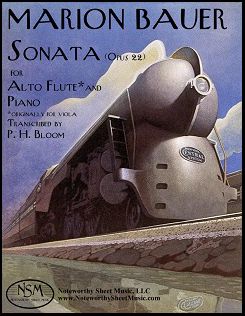 Sonata, Op.22, by Marion Bauer
Sonata, Op.22, by Marion Bauer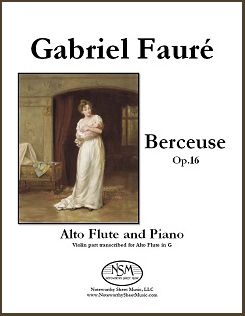
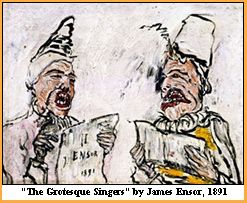 Sing-Along Materials, arranged by John W. Pratt
Sing-Along Materials, arranged by John W. Pratt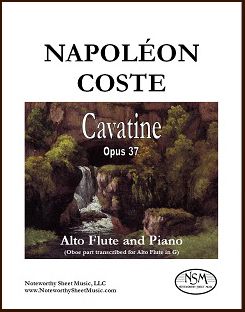 Cavatine, Op.37, by Napoléon Coste
Cavatine, Op.37, by Napoléon Coste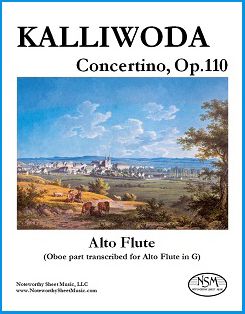 Concertino, Op.110, by J. W. Kalliwoda
Concertino, Op.110, by J. W. Kalliwoda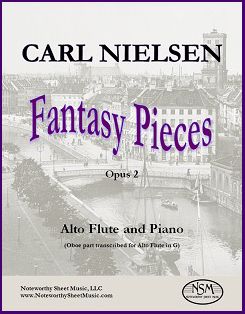 Fantasy Pieces, Op.2, by Carl Nielsen
Fantasy Pieces, Op.2, by Carl Nielsen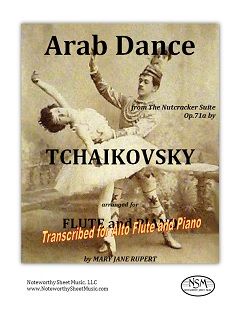 Arab Dance, by P. Tchaikovsky
Arab Dance, by P. Tchaikovsky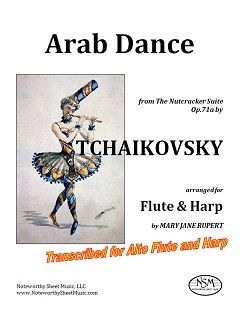 Alto Flute & Harp Edition: Harp score, 6 pages; Alto Flute part, 1 page; Total, 10 pages. $7.99
Alto Flute & Harp Edition: Harp score, 6 pages; Alto Flute part, 1 page; Total, 10 pages. $7.99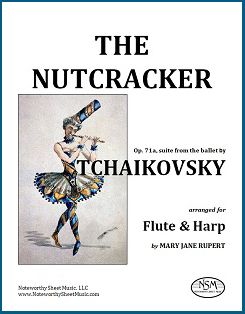 The Nutcracker, by P. Tchaikovsky
The Nutcracker, by P. Tchaikovsky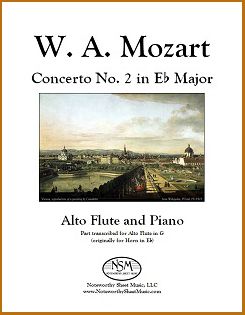 Concerto No.2 in E-flat major, K.417, by W. A. Mozart
Concerto No.2 in E-flat major, K.417, by W. A. Mozart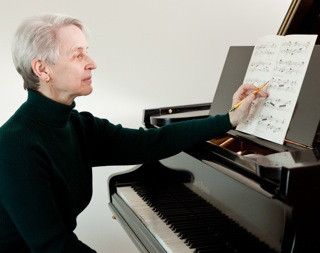 Duos, by Elizabeth Vercoe
Duos, by Elizabeth Vercoe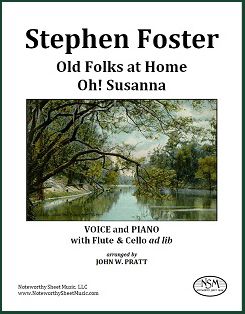 Old Folks at Home and Oh! Susanna, by Stephen Foster
Old Folks at Home and Oh! Susanna, by Stephen Foster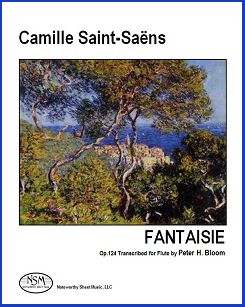 Fantaisie, Op.124, by Camille Saint-Saëns
Fantaisie, Op.124, by Camille Saint-Saëns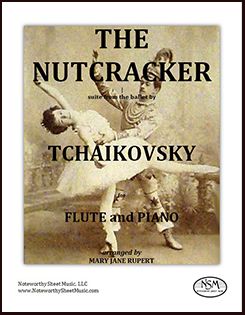 The Nutcracker, by P. Tchaikovsky
The Nutcracker, by P. Tchaikovsky
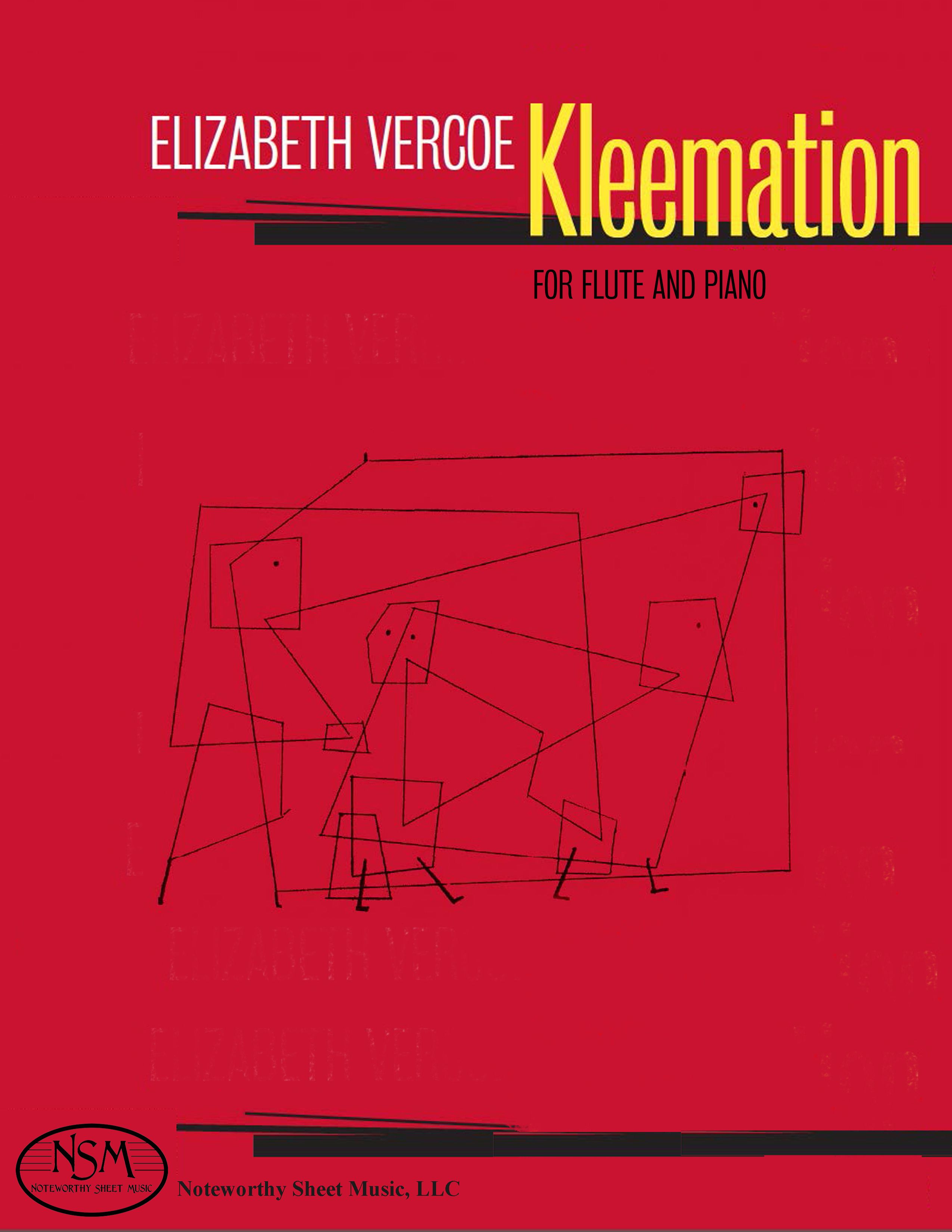 Kleemation, by Elizabeth Vercoe
Kleemation, by Elizabeth Vercoe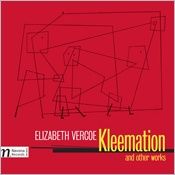
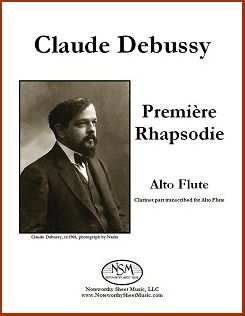 Première Rhapsodie, by Claude Debussy
Première Rhapsodie, by Claude Debussy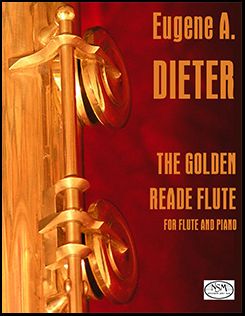 The Golden "Reade" Flute, by Eugene A. Dieter
The Golden "Reade" Flute, by Eugene A. Dieter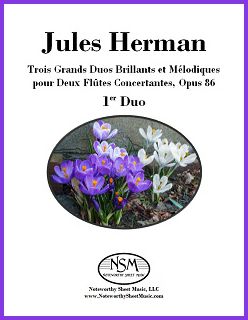 Trois Grands Duos Brillants et Mélodiques pour Deux Flûtes Concertantes, by Jules Herman
Trois Grands Duos Brillants et Mélodiques pour Deux Flûtes Concertantes, by Jules Herman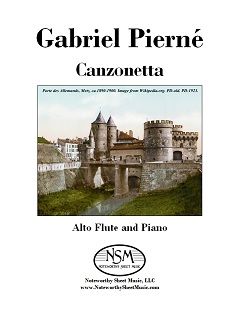 Canzonetta, Op.19, by G. Pierné
Canzonetta, Op.19, by G. Pierné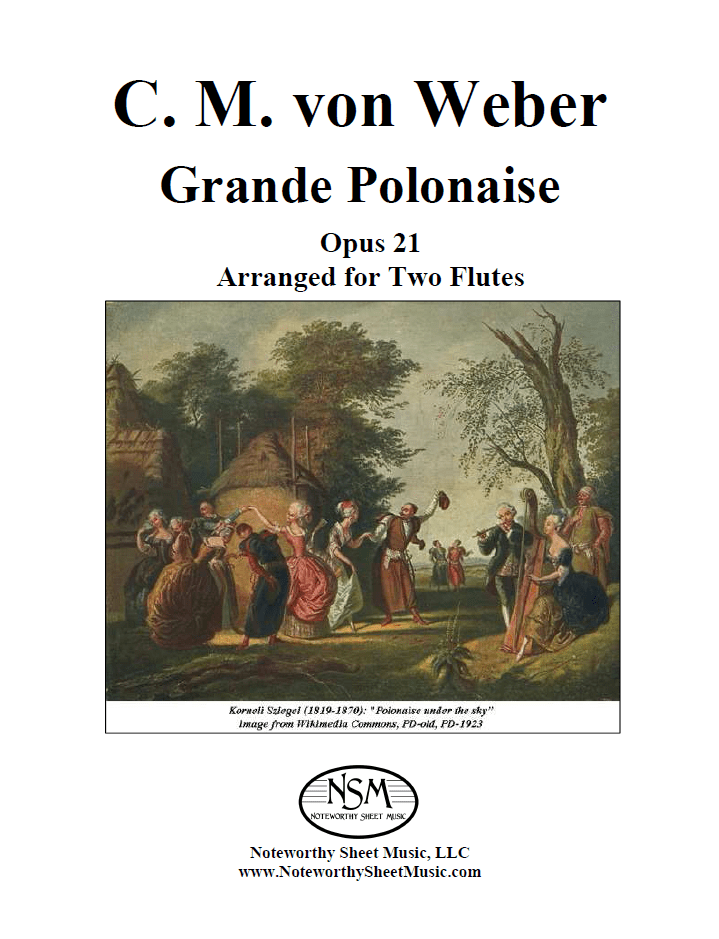 Grande Polonaise, Op.21, by Carl Maria von Weber
Grande Polonaise, Op.21, by Carl Maria von Weber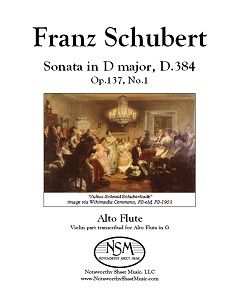 Sonatas, Op.137, by F. Schubert
Sonatas, Op.137, by F. Schubert